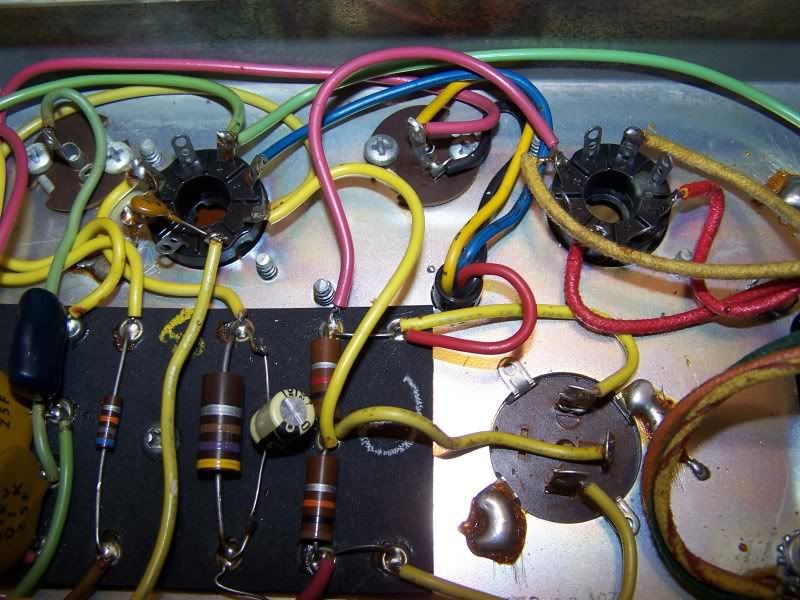Hello Everyone!
I'm a relative newb to amps. My only experience is buildig a mojo tweed deluxe kit (whic I want to marry and have children with). A friend has showed me how to safely drain caps.
I will get right to the main question and then explain the problem:
Is there a simple way to test an OT for failure without buying additonal parts?
as in... is there a way with my DMM to test it?
Heres whats going on. I bought a 73 vibrochamp. Cool little amp! played well for a couple days. I cranked it often. Then a couple days ago i had it on 10 and stepped on a dod buzzbox. The buzzbox is a horrible noise making effect. It sounds like your amp is breaking when you step on it. Well... I stepped on it and it sounded like my amp was breaking as usual...but then the amp DID break. haha. It just cut out dead silent, no hiss hum no nothing. can a pedal kill an amp? sure seemed that way but maybe its a coincidence? can the combo of an amp on ten and a super noisey pedal kill an amp?
anyway, changed tubes, all of em. No joy. Changed speaker. No joy. Open chassis and poked around the live amp with a chopstick. No Joy. No loose connections, nothing obviously exploded. No burnt smell, tho the amp did come from a smoking home and smells like an ashtray oto the max so its hard to tell. Voltages read good at caps. speaker connection checked well. guitar and chords etc all swapped out.
so Im thinking blown OT?so again...easy way to test it?
how do I choose a replacement OT?
The number codes o the back are :022905 and next line reads 606-3-01
heres some pics of the transformer and where it connects inside the amp.


as you can see, someone has replaced one of the caps with a different value. i might change that back...or not...dunno. I also wanna slow down the trem, its way too fast, and to do that i need to replace those two ceramic disc caps (.01's) you see in the very far left corner of the photo. If I have to replace the OT I wll need to make a connection to the board. I'm wondering if I can do all this without removing the board from the chassis? The grounds are connected from board to chassis by a bare stiff lead so taking the board out would be a major pain it looks like. Looks like I'd have t rewire the whole thing basically. Can I just heat up the joints and drop the components in with out removing the board?
Thanks a ton for the help guys and for your patience with me. i trying to learn
Cheers
-Ben
I'm a relative newb to amps. My only experience is buildig a mojo tweed deluxe kit (whic I want to marry and have children with). A friend has showed me how to safely drain caps.
I will get right to the main question and then explain the problem:
Is there a simple way to test an OT for failure without buying additonal parts?
as in... is there a way with my DMM to test it?
Heres whats going on. I bought a 73 vibrochamp. Cool little amp! played well for a couple days. I cranked it often. Then a couple days ago i had it on 10 and stepped on a dod buzzbox. The buzzbox is a horrible noise making effect. It sounds like your amp is breaking when you step on it. Well... I stepped on it and it sounded like my amp was breaking as usual...but then the amp DID break. haha. It just cut out dead silent, no hiss hum no nothing. can a pedal kill an amp? sure seemed that way but maybe its a coincidence? can the combo of an amp on ten and a super noisey pedal kill an amp?
anyway, changed tubes, all of em. No joy. Changed speaker. No joy. Open chassis and poked around the live amp with a chopstick. No Joy. No loose connections, nothing obviously exploded. No burnt smell, tho the amp did come from a smoking home and smells like an ashtray oto the max so its hard to tell. Voltages read good at caps. speaker connection checked well. guitar and chords etc all swapped out.
so Im thinking blown OT?so again...easy way to test it?
how do I choose a replacement OT?
The number codes o the back are :022905 and next line reads 606-3-01
heres some pics of the transformer and where it connects inside the amp.


as you can see, someone has replaced one of the caps with a different value. i might change that back...or not...dunno. I also wanna slow down the trem, its way too fast, and to do that i need to replace those two ceramic disc caps (.01's) you see in the very far left corner of the photo. If I have to replace the OT I wll need to make a connection to the board. I'm wondering if I can do all this without removing the board from the chassis? The grounds are connected from board to chassis by a bare stiff lead so taking the board out would be a major pain it looks like. Looks like I'd have t rewire the whole thing basically. Can I just heat up the joints and drop the components in with out removing the board?
Thanks a ton for the help guys and for your patience with me. i trying to learn

Cheers
-Ben
Comment